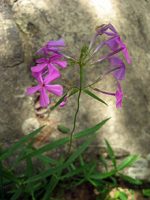 This herbaceous perennial, also called marsh phlox, is a member of the Polemoniaceae family that also include Jacob’s ladder. It is native to midwesternand southeastern US from Maryland to Wisconsin, south to Florida and Texas where it grows in moist to wet areas of prairies, meadows, and woodlands. Plants grow up to 4′ tall from a taproot and have unbranched, slender, hairless stems bearing medium green opposite lanceolate leaves. From late spring to early summer, terminal dome-shaped clusters up to 12″ long appear bearing 3- 20 pink to lavender, fragrant flowers. Each tubular flower is up to 1′ across and has 5 petal like lobes. The flowers are attractive to hummingbirds and butterflies. Smooth phlox tolerates heat, humidity, and moist soil well, band unlike most other phlox, is resistant to root rot and powdery mildew. The genus name, Phlox, is the Greek word for flame and refers to he vivid color of some varieties. The specific epithet, glaberrima, is the superlative form of the Latin adjective glaber and means very hairless, referring to the lack of hairs on all parts of the plant.
This herbaceous perennial, also called marsh phlox, is a member of the Polemoniaceae family that also include Jacob’s ladder. It is native to midwesternand southeastern US from Maryland to Wisconsin, south to Florida and Texas where it grows in moist to wet areas of prairies, meadows, and woodlands. Plants grow up to 4′ tall from a taproot and have unbranched, slender, hairless stems bearing medium green opposite lanceolate leaves. From late spring to early summer, terminal dome-shaped clusters up to 12″ long appear bearing 3- 20 pink to lavender, fragrant flowers. Each tubular flower is up to 1′ across and has 5 petal like lobes. The flowers are attractive to hummingbirds and butterflies. Smooth phlox tolerates heat, humidity, and moist soil well, band unlike most other phlox, is resistant to root rot and powdery mildew. The genus name, Phlox, is the Greek word for flame and refers to he vivid color of some varieties. The specific epithet, glaberrima, is the superlative form of the Latin adjective glaber and means very hairless, referring to the lack of hairs on all parts of the plant.
Type: Herbaceous perennial
Bloom: Clusters of pink tubular flowers with 5 petal like lobes in late spring to early summer
Size: 2-4′ H x 2-2.5′ W
Light: Full sun
Soil: Fertile, moderately moist, well-drained; does not tolerate drought.
Hardiness: Zones 3-8
Care: Deadhead to prolong bloom and prevent self-seeding.
Pests and Diseases: Spider mites
Propagation: Seed, division
Companion Plants: Amsonia tabernaemontana, Penstemon digitalis, Campanula spp
Outstanding Selections:’Morris Berd’
Photo Credit: Wikipedia